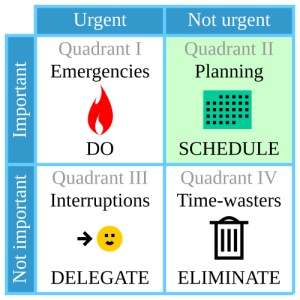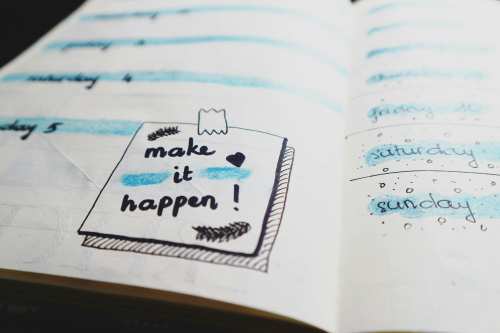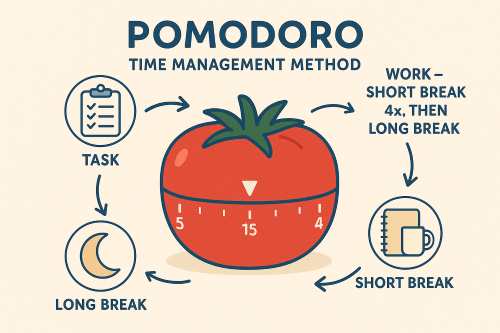Here’s a sobering fact: studies show that only 3% of people have written goals and plans for their future. But here’s the kicker – that tiny percentage earns 10 times more than those who don’t plan ahead. Pretty wild, right? And we’re not just talking about money here. We’re talking about overall life satisfaction, career success, relationships, health – basically everything that makes life worth living.
So why do most of us avoid planning our future like it’s some kind of plague? Well, I get it. The whole thing feels overwhelming (where do you even start?). There’s this fear that if you write something down, you’re somehow locked into it forever. And let’s be honest – the future is uncertain, so why bother planning when everything might change anyway?
But here’s what I’ve learned: those who plan don’t just stumble into success. They create it. And that’s exactly what this guide is going to help you do.
Whether you’re fresh out of college wondering what the heck comes next, stuck in your 30s feeling like life is passing you by, or even in your 50s thinking it might be too late to change course (spoiler alert: it’s not), this guide has your back. We’re going to break down how to plan your future into bite-sized, doable steps that won’t make your head spin.
By the end of this, you’ll have a clear roadmap – not some vague “I want to be happy” nonsense, but a real, actionable plan that’ll get you from where you are now to where you actually want to be.
Why Future Planning Actually Matters (And It’s Not What You Think)
OK folks, let me tell you something that might blow your mind. It’s not the big dramatic moments that shape your life. It’s the tiny decisions you make every single day. That’s the compound effect in action, and it’s absolutely insane how powerful it is.
Think about it this way: choosing to read for 30 minutes instead of scrolling social media doesn’t seem like a big deal today. But do that for a year? You’ve read 20+ books while others have… well, seen a lot of cat videos. Five years? You’re basically a different person with a completely different knowledge base.
Take Warren Buffett – the guy started investing when he was 11 years old. Not because he was some child prodigy (though he was pretty smart), but because he had a plan. Or look at Oprah, who mapped out her media empire decades before it happened. These aren’t accidents, people.
And here’s the flip side that nobody likes to talk about. I’ve met way too many people in their 60s who say things like “I wish I had started saving earlier” or “I should have taken more risks when I was younger” or “I never really figured out what I wanted to do with my life.” Ouch, right?
But when you plan your future – and I mean really plan it – something magical happens. That anxiety about “what if” starts to fade because you’ve already thought through the scenarios. Decision-making becomes clearer because you know where you’re headed. And opportunities? They start showing up everywhere because you actually know what to look for.
Getting Started: Where Are You Right Now?
Alright, before we start building your future, we need to figure out where you’re standing today. It’s like using GPS – you can’t get directions without knowing your starting point, right?
First up, let’s talk values. I know, I know, this sounds like something from a self-help seminar, but stick with me here. Your values are basically your internal compass, and if you don’t know what they are, you’ll end up chasing life goals that make you miserable.
Here’s a quick exercise: think about the times in your life when you felt most proud, most fulfilled, most “you.” What was happening? What values were you honoring? Maybe it was helping others, creating something beautiful, solving complex problems, or building deep relationships. Write these down – seriously, grab a pen right now.
Next, let’s get brutally honest about your strengths and weaknesses. And I mean brutal. What are you naturally good at? What makes you want to hide under a rock? Don’t worry, we all have both. The key is knowing them so you can plan around them.
Finally, rate your current life satisfaction in these areas on a scale of 1-10:
- Career and work fulfillment
- Financial security and growth
- Relationships and social connections
- Physical and mental health
- Personal development and learning
- Lifestyle and daily experiences
Be honest here. If your career is a 4 and your relationships are a 9, that tells you something important about where to focus your future planning energy.
Vision Creation: Painting Your Future Picture
OK, here’s where things get exciting (and maybe a little scary). We’re going to create your 10-year vision. Why 10 years? Because it’s far enough away to dream big but close enough to feel real.
Close your eyes for a second. It’s 10 years from now. You wake up in the morning. Where are you? What does your day look like? Who’s in your life? What kind of work are you doing? How do you feel about yourself and your life?
Now, let’s get specific about different areas:
Career and Professional Growth: Are you climbing the corporate ladder, running your own business, or maybe doing something completely different? What impact are you making? What’s your reputation in your field?
Financial Goals: What’s your net worth? Are you financially free? Do you own property? Can you travel when you want? Be specific with numbers here – “comfortable” isn’t a plan.
Relationships and Family: Are you married, single, or somewhere in between? Do you have kids? What do your friendships look like? How much time do you spend with family?
Health and Wellness: How do you feel in your body? What’s your energy level like? What habits have you built around fitness, nutrition, and mental health?
Personal Development: What new skills have you mastered? What knowledge have you gained? How have you grown as a person?
Lifestyle and Experiences: Where do you live? How do you spend your free time? What adventures have you had? What legacy are you building?
Here’s the key: make it specific and measurable. Instead of “I want to be financially successful,” try “I want to have a net worth of $500,000 and passive income of $5,000 per month.” See the difference?
But watch out for these common vision pitfalls: don’t make it all about external stuff (money, status, things), don’t ignore the people in your life, and don’t create a vision that sounds like it belongs to someone else. This is YOUR life we’re planning here.
Goal Setting Framework: Making Dreams Actionable
Alright, now we need to turn that beautiful vision into actual goal setting you can work toward. And yes, we’re going to talk about SMART goals, but I promise to make it less boring than your last corporate training.
SMART stands for Specific, Measurable, Achievable, Relevant, and Time-bound. Let’s break it down with a real example:
Instead of “I want to get in shape” (vague and unmeasurable), try “I want to lose 20 pounds and run a 10K race within 6 months by working out 4 times per week and tracking my nutrition.” See how much clearer that is?
Now here’s where it gets interesting – you need to create a hierarchy of goals. Think of it like building a pyramid:
- 10-year vision (the big picture)
- 5-year major goals (significant milestones)
- 3-year objectives (substantial progress markers)
- 1-year targets (annual achievements)
- Quarterly milestones (seasonal checkpoints)
- Monthly actions (monthly focus areas)
For example, if your 10-year vision includes financial freedom, your breakdown might look like:
- 10-year: Net worth of $1 million
- 5-year: Net worth of $400,000, multiple income streams established
- 3-year: Net worth of $200,000, side business generating $2,000/month
- 1-year: Net worth of $75,000, side business launched
- This quarter: Save $5,000, complete business plan
- This month: Open high-yield savings account, research business ideas
The magic happens when you write effective goal statements. Start with action verbs, include specific numbers and deadlines, and make sure you can actually measure progress. “Increase my income by 25% within 12 months by completing two professional certifications and negotiating a raise” beats “make more money” every single time.
Creating Your Action Plan: From Goals to Daily Actions
This is where the rubber meets the road, folks. You’ve got your vision, you’ve set your goals, now we need to figure out exactly how you’re going to make this stuff happen.
First, let’s break those big goals into manageable steps. Take that financial goal we mentioned earlier. “Launch a side business” might break down into:
- Research profitable business ideas (2 weeks)
- Validate business concept with potential customers (3 weeks)
- Create business plan and financial projections (4 weeks)
- Set up legal structure and business accounts (2 weeks)
- Build minimum viable product or service (8 weeks)
- Launch and acquire first 10 customers (12 weeks)
Now you’ve got specific tasks instead of one overwhelming goal. Much better, right?
Next up: prioritization. You can’t do everything at once (trust me, I’ve tried). I love the Eisenhower Matrix for this – it sorts tasks into four categories: urgent and important, important but not urgent, urgent but not important, and neither urgent nor important. Guess which quadrant most future-building activities fall into? That’s right – important but not urgent. These are the tasks that build your future but often get pushed aside for “urgent” stuff that doesn’t really matter.

Timeline creation is crucial here. Work backward from your deadlines. If you want to launch that business in 6 months, when do you need to complete each step? Build in buffer time because life happens, and things always take longer than you think.
Don’t forget to identify your resources. What skills do you need to develop? How much money will this require? Who do you need to connect with? What tools or equipment do you need? Make a list and figure out how to acquire what’s missing.
And here’s something most people skip: anticipating obstacles. What could go wrong? What would you do if it did? Having a Plan B (and maybe a Plan C) will keep you moving forward when things get tough.
The Planning Tools and Systems That Actually Work
Let me guess – you’re wondering what app or system to use for all this life planning, right? Well, here’s the thing: the best system is the one you’ll actually use consistently.
Some people swear by digital tools. There’s Notion for the super-organized, Todoist for task management, or even something simple like Google Sheets. The advantage? Everything’s searchable, you can access it anywhere, and you can easily make changes.
But don’t sleep on good old-fashioned pen and paper. There’s something about physically writing things down that makes them feel more real. Plus, you can’t get distracted by notifications when you’re writing in a notebook.
Here’s what I recommend: start simple. Pick one tool (digital or analog) and stick with it for at least 3 months. You can always switch later, but constantly changing systems is just another form of procrastination.
Whatever system you choose, make sure it includes:
- Your long-term vision and goals
- Monthly and weekly planning sessions
- Daily task lists
- Progress tracking
- Regular review schedules
And here’s a pro tip: block time in your calendar for planning sessions. Treat them like important meetings (because they are). I do mine every Sunday morning with a cup of coffee. It’s become one of my favorite rituals.
Overcoming the Challenges (Because There Will Be Challenges)
OK, let’s get real for a minute. Planning your future sounds great until life punches you in the face. The economy crashes, you get laid off, your relationship ends, or a global pandemic shuts down the world. What then?
First, remember that uncertainty is not the enemy of planning – it’s exactly why planning matters. When you have a clear vision and flexible plans, you can adapt without losing sight of what matters most to you.
Here’s how to deal with the fear of commitment that stops so many people: your plans are not prison sentences. They’re your best guess about what you want based on what you know today. As you learn and grow, your plans can (and should) evolve.
What about when plans don’t work out? Well, that’s going to happen. A lot. The key is to see these moments as course corrections, not failures. Ask yourself: What did I learn? What would I do differently? How can I adjust my approach?
And please, please don’t fall into the perfectionism trap. You don’t need to have everything figured out before you start. Perfect plans executed poorly will always lose to decent plans executed consistently.
As for balancing planning with spontaneity – you absolutely need both. Your plan creates the foundation that gives you the freedom to be spontaneous. When you know where you’re going, you can take detours without getting completely lost.
Regular Review and Adjustment: Keeping Your Plans Alive
Here’s where most people mess up: they create these beautiful plans and then… forget about them. Your plans are living documents, not museum pieces.
Set up regular review sessions:
Monthly reviews: How did this month go? What worked? What didn’t? What do you need to adjust for next month?
Quarterly assessments: Are you on track with your bigger goals? Do any of your goals need to be revised? What obstacles are you facing?
Annual vision refresh: Is your 10-year vision still exciting to you? What have you learned about yourself this year? What needs to change?
Don’t be afraid to pivot when necessary. Sometimes the best thing you can do is dramatically change course. The years you spent pursuing one path aren’t wasted if they taught you what you don’t want or led you to something better.
Learn from everything – your wins, your failures, your unexpected opportunities. Each experience gives you better information for future planning.
Your Next Steps: From Planning to Living
Alright, we’ve covered a lot of ground here. Let me recap the key principles that’ll serve you well:
- Start with self-awareness – you can’t plan a future that ignores who you really are
- Create a specific, compelling vision – vague dreams stay dreams
- Break big goals into small, actionable steps – you eat an elephant one bite at a time
- Choose systems that work for your personality – the best plan is the one you’ll actually follow
- Review and adjust regularly – flexibility is a strength, not a weakness
- Take action imperfectly – done is better than perfect
Look, I get it. This might feel overwhelming. You might be thinking, “I don’t even know what I want for dinner tonight, how am I supposed to plan the next 10 years?”
But here’s the beautiful truth: you don’t have to start with perfect clarity. You just have to start. Take the next step, even if it’s a small one. Even if you’re not sure it’s the right one.
Your future self is counting on the decisions you make today. Not the perfect decisions, just the intentional ones. So what’s it going to be?
Frequently Asked Questions
How far ahead should I plan my future?
I recommend a 10-year vision with specific goals broken down into 5-year, 3-year, and 1-year timeframes. This gives you the big picture while keeping things actionable.
What if I don’t know what I want in life?
Start with what you know you don’t want, then experiment with small steps toward things that interest you. Clarity comes through action, not just thinking.
How often should I review my future plans?
Monthly check-ins, quarterly goal reviews, and annual vision refreshes work well for most people. Adjust based on how fast your life changes.
Is it too late to start planning at my age?
It’s never too late. Whether you’re 25 or 65, you have years ahead of you. The best time to plant a tree was 20 years ago; the second best time is now.
How do I balance planning with living in the present?
Planning actually enhances present-moment living by reducing anxiety about the future. Spend 80% of your time in the present and 20% planning ahead.
What’s the difference between goals and dreams?
Dreams are wishes; goals are dreams with deadlines and action plans. Both are important, but only goals get accomplished.
How do I stay accountable to my future plans?
Share your goals with trusted friends, join accountability groups, track your progress visually, and celebrate small wins along the way.
Photo by Bich Tran






